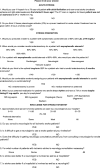The role of hospitalists in the acute care of stroke patients
- PMID: 20461115
- PMCID: PMC2860551
- DOI: 10.1007/s11936-010-0068-7
The role of hospitalists in the acute care of stroke patients
Abstract
Stroke care has become progressively more complicated with advances in therapies necessitating timely intervention. There are multiple potential providers of stroke care, which traditionally has been the province of general neurologists and primary care physicians. These new players, be they vascular neurologists, neurohospitalists, internal medicine hospitalists, or neurocritical care physicians, at the bedside or at a distance, are poised to make a significant impact on our care of stroke patients. The collaborative model of care may be or become the most prevalent as physicians apply their distinct skill sets to the complex care of inpatients with cerebrovascular disease.
Figures
Similar articles
-
Invited article: is it time for neurohospitalists?Neurology. 2008 Apr 8;70(15):1282-8. doi: 10.1212/01.wnl.0000308949.45423.13. Epub 2008 Mar 12. Neurology. 2008. PMID: 18337585 Review.
-
Neurohospitalists: an emerging model for inpatient neurological care.Ann Neurol. 2008 Feb;63(2):135-40. doi: 10.1002/ana.21355. Ann Neurol. 2008. PMID: 18306369 Review.
-
Should there be pediatric neurohospitalists?Neurology. 2013 Mar 5;80(10):957-62. doi: 10.1212/WNL.0b013e3182840bd3. Epub 2013 Jan 16. Neurology. 2013. PMID: 23325904
-
Collaborative Comanagement Between Neurohospitalists and Internal Medicine Hospitalists Decreases Provider Costs and Enhances Satisfaction With Neurology Care at an Academic Medical Center.Neurohospitalist. 2018 Apr;8(2):74-81. doi: 10.1177/1941874417735173. Epub 2017 Oct 23. Neurohospitalist. 2018. PMID: 29623157 Free PMC article.
-
Update in Pediatric Neurocritical Care: What a Neurologist Caring for Critically Ill Children Needs to Know.Semin Neurol. 2024 Jun;44(3):362-388. doi: 10.1055/s-0044-1787047. Epub 2024 May 24. Semin Neurol. 2024. PMID: 38788765 Review.
Cited by
-
Does Hospitalist Directed Care for Acute Ischemic Stroke Patients Improve Adherence to "Get with the Guidelines"?J Vasc Interv Neurol. 2016 Oct;9(2):30-33. J Vasc Interv Neurol. 2016. PMID: 27829968 Free PMC article.
-
A Nationwide Analysis of Outcomes of Weekend Admissions for Intracerebral Hemorrhage Shows Disparities Based on Hospital Teaching Status.Neurohospitalist. 2016 Apr;6(2):51-8. doi: 10.1177/1941874415601164. Epub 2015 Sep 3. Neurohospitalist. 2016. PMID: 27053981 Free PMC article.
-
Neurohospitalists: an emerging subspecialty.Curr Neurol Neurosci Rep. 2012 Aug;12(4):481-8. doi: 10.1007/s11910-012-0273-8. Curr Neurol Neurosci Rep. 2012. PMID: 22544508 Review.
-
What's the Future of Vascular Neurology?Neurotherapeutics. 2023 Apr;20(3):605-612. doi: 10.1007/s13311-023-01374-4. Epub 2023 May 2. Neurotherapeutics. 2023. PMID: 37129762 Free PMC article. Review.
References
References and Recommended Reading
Papers of particular interest, published recently, have been highlighted as: • Of importance•• Of major importance
-
- Lloyd-Jones D, Adams RJ, Brown TM, et al. Heart disease and stroke statistics—2010 update. a report from the American Heart Association. Circulation. 2010;121:e54–e65. - PubMed
-
- Zoppo GJ, Saver JL, Jauch EC, et al. Expansion of the time window for treatment of acute ischemic stroke with intravenous tissue plasminogen activator: a science advisory from the American Heart Association/American Stroke Association. Stroke. 2009;40:2945–2948. doi: 10.1161/STROKEAHA.109.192535. - DOI - PMC - PubMed


